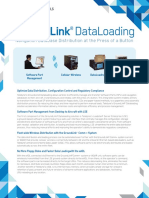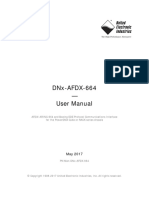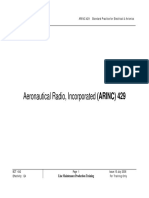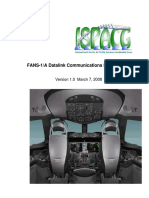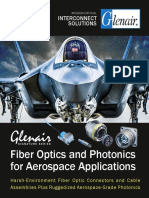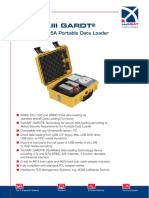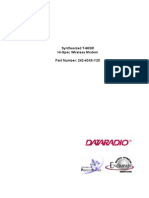0 ratings0% found this document useful (0 votes)
153 viewsCSDB
CSDB is an asynchronous linear broadcast bus that specifies the use of twisted pair cable. It defines low and high-speed options of 12.5kbps and 50kbps. CSDB uses 11-bit bytes consisting of start, data, parity and stop bits within message frames. Error detection includes parity checks and optional checksums. The document discusses CSDB specifications, operations, integration considerations and comparisons to ARINC 429 and ARINC 629 standards.
Uploaded by
SBRCopyright
© © All Rights Reserved
Available Formats
Download as PPTX, PDF, TXT or read online on Scribd
0 ratings0% found this document useful (0 votes)
153 viewsCSDB
CSDB is an asynchronous linear broadcast bus that specifies the use of twisted pair cable. It defines low and high-speed options of 12.5kbps and 50kbps. CSDB uses 11-bit bytes consisting of start, data, parity and stop bits within message frames. Error detection includes parity checks and optional checksums. The document discusses CSDB specifications, operations, integration considerations and comparisons to ARINC 429 and ARINC 629 standards.
Uploaded by
SBRCopyright
© © All Rights Reserved
Available Formats
Download as PPTX, PDF, TXT or read online on Scribd
You are on page 1/ 23
CSDB
Commercial Standard Digital Bus
• CSDB is an asynchronous linear broadcast bus,
specifying the use of a twisted, shielded pair
cable for device interconnection. Two bus
speeds are defined in the CSDB specification.
A low-speed bus operates at 12,500 bits per
second (bps) and a high-speed bus operates at
50,000 bps. The bus uses twisted,
unterminated, shielded pair cable and has
been tested to lengths of 50 m.
Uni-Directional Bus
Bi-Directional Bus
Gateway
If the other bus is ARINC 429 compliant, then
messages directed through the gateway from
CSDB are converted to the ARINC 429 protocol,
and vice versa.
Basic Bus Operation
• Continuous repetition
• Non-continuous repetition
• “Burst” transmissions
CSDB message framework
CSDB
• For CSDB, bytes consist of 11 bits: a start bit, 8
data bits, a parity bit, and a stop bit.
• A particular frame is defined from the start of
one synchronization block to the start of the
next synchronization block.
• A message block contains an address byte, a
status byte, and a variable number of data
bytes.
CSDB
• The theoretical bus data rate for a data bus
operating at 50,000 bps with an 11-bit data
byte, is 4545 bytes per second.
CSDB Error Detection and Correction
• Parity
– A parity bit is appended after each byte of data in
a CSDB transmission.
• Checksums
– It is expected that the receiving unit will accept as
a valid message the first message block which
contains a verifiable checksum.
Bus User Monitoring
• The bus frame, consisting of the
synchronization block and message block, may
be checked for proper format and content.
• A typical byte, consisting of start, stop, data,
and parity bits, may be checked for proper
format.
Integration Considerations
• Physical Integration
– 10 receivers on a single bus
– Up to 50 m in length
– LRU connected to a CSDB must satisfy the
electrical signals and bit timing
– Protection against short-circuits
– Avoid potential future integration problems
Integration Considerations
• Logical Integration
– The bit patterns that initiate a message block, and
the start bit, data bits, parity bit, and stop bit
pattern that comprises each byte of the message.
– Control the number of bytes in each message and
ensure that all the messages on a particular bus
are of the same length.
Integration Considerations
• Software Integration
– The authorized messages and in constraining their
signaling rate and update rate
– Bus frame loading
Integration Considerations
• The detailed message block definitions give
the interpretation of the address, status byte,
and data words for each available message.
• Subsystem should provide the messages
required by other LRUs.
• All the messages on a particular bus are of the
same length.
ARINC 629
• ARINC 629 was introduced in May 1995 and is
currently used on the Boeing 777, Airbus A330
and A340 aircraft.
• The ARINC 629 bus is a true data bus in that
the bus operates as a multiple-source,
multiple sink system.
• Additional units can be fairly readily accepted
physically on the data bus.
ARINC 629
• ARINC 629 is the ability to accommodate up to
a total of 128 terminals.
• It supports a data rate of 2 Mbps.
• ARINC 629 uses the time based, collision-
avoidance concept.
• ARINC 629 uses 20 bit data word format.
ARINC 629
ARINC 429
ARINC 629 Word Format
ARINC 629 Word Format
• The first three bits are related to word time
synchronization.
• The next 16 bits are the data contents.
• The final bit is a parity bit.
ARINC 629
• The ARINC 629 data bus cable consists of an
unshielded twisted pair of wires.
• The wires are #20 AWG and are bonded together
continuously along their length.
• The cables can be up to 100 meters long and have
no provisions for field splicing.
• ARINC 629 is defined for both voltage and current
modes of operation.
• One attractive feature of ARINC 629 is that fiber
optic interface.
ARINC 629
• ARINC 629 data transmitted in groups called
messages.
• Messages are comprised of word strings, up to
31 word strings can be in a message.
• Word strings begin with a label followed by up
to 256 data words.
• Each label word and data word is 20 bits
You might also like
- Assessing The Network With Common Security Tools 3e - Merabi TakashviliNo ratings yetAssessing The Network With Common Security Tools 3e - Merabi Takashvili13 pages
- Teledyne GroundLink Dataloading BrochureNo ratings yetTeledyne GroundLink Dataloading Brochure2 pages
- Format Support Letter Incubator Funded by GovernmentNo ratings yetFormat Support Letter Incubator Funded by Government3 pages
- Tso-C151b Terrain Awareness and Warning SystemNo ratings yetTso-C151b Terrain Awareness and Warning System49 pages
- Boeing 777 Mode S Transponder (Honeywell)No ratings yetBoeing 777 Mode S Transponder (Honeywell)3 pages
- Ifr6015 Military Flight Line Test Set Brochures en100% (1)Ifr6015 Military Flight Line Test Set Brochures en2 pages
- Arinc 429 Data Bus - Aeronautical Radio IncorporationNo ratings yetArinc 429 Data Bus - Aeronautical Radio Incorporation25 pages
- MIL-HDBK-225A Synchros Description and OperationNo ratings yetMIL-HDBK-225A Synchros Description and Operation236 pages
- Ata 46 Initialization of The ATSU RouterNo ratings yetAta 46 Initialization of The ATSU Router5 pages
- Indu Altimeter Manual: © Kanardia D.O.O. September 2020100% (1)Indu Altimeter Manual: © Kanardia D.O.O. September 202032 pages
- Gama Publication 11-Arinc 429general Aviation Subset Version 6.0-1No ratings yetGama Publication 11-Arinc 429general Aviation Subset Version 6.0-189 pages
- FANS-1/A Datalink Communications Environment: Version 1.0 March 7, 2008No ratings yetFANS-1/A Datalink Communications Environment: Version 1.0 March 7, 200827 pages
- Form-Fit Ads-B Compliant Mode S Transponders: The Nextgen TransponderNo ratings yetForm-Fit Ads-B Compliant Mode S Transponders: The Nextgen Transponder2 pages
- Description Features Technical Specifications: Inmarsat Satcom High Gain AntennaNo ratings yetDescription Features Technical Specifications: Inmarsat Satcom High Gain Antenna1 page
- Ada 486580JET ENGINE CONTROL USING ETHERNET WITH A BRAINNo ratings yetAda 486580JET ENGINE CONTROL USING ETHERNET WITH A BRAIN20 pages
- Basic Avionics Part 1 (ATA CH 22, 23, 31)No ratings yetBasic Avionics Part 1 (ATA CH 22, 23, 31)109 pages
- ARINC - The Ultimate Guide To Modern Avionics Protocol (2024) - Dheeraj Punia - Logic Fruit TechnologiesNo ratings yetARINC - The Ultimate Guide To Modern Avionics Protocol (2024) - Dheeraj Punia - Logic Fruit Technologies21 pages
- Aircraft Manual Supplement: B737 PM-CPDLC Acars Cmu Ii UpgradeNo ratings yetAircraft Manual Supplement: B737 PM-CPDLC Acars Cmu Ii Upgrade45 pages
- 12-00009WD - F - Audio Interface (Garmin GMA 1347D)No ratings yet12-00009WD - F - Audio Interface (Garmin GMA 1347D)11 pages
- Fiber Optics For Aerospace ApplicationsNo ratings yetFiber Optics For Aerospace Applications62 pages
- PDL MK - Iii Gardt: ® ARINC 615/615A Portable Data LoaderNo ratings yetPDL MK - Iii Gardt: ® ARINC 615/615A Portable Data Loader2 pages
- Part 145 Overseas Airworthiness Approved OrganisationsNo ratings yetPart 145 Overseas Airworthiness Approved Organisations146 pages
- Subject: Use of Multi-Core Processors Date: XXX AC No: AC 20-193 Initiated By: AIR-622100% (1)Subject: Use of Multi-Core Processors Date: XXX AC No: AC 20-193 Initiated By: AIR-62217 pages
- Instructions Continued Airworthiness: Aeronautlcal Accessories, IncNo ratings yetInstructions Continued Airworthiness: Aeronautlcal Accessories, Inc12 pages
- Aerospace Actuators V3: European Commercial Aircraft and Tiltrotor AircraftFrom EverandAerospace Actuators V3: European Commercial Aircraft and Tiltrotor AircraftNo ratings yet
- AR120&AR150&AR160&AR200&AR500&AR510&AR1200&AR2200&AR3200&AR3600 Hardware DescriptionNo ratings yetAR120&AR150&AR160&AR200&AR500&AR510&AR1200&AR2200&AR3200&AR3600 Hardware Description1,557 pages
- 2000-06 The Computer Paper - Ontario EditionNo ratings yet2000-06 The Computer Paper - Ontario Edition140 pages
- Pulse Connect Secure: Release Notes PCS 9.1R6 Build 5801 PDC 9.1R6 Build 2223 Default ESAP Version: ESAP 3.4.8No ratings yetPulse Connect Secure: Release Notes PCS 9.1R6 Build 5801 PDC 9.1R6 Build 2223 Default ESAP Version: ESAP 3.4.822 pages
- Lista Top Fornecedores - 220725 - 202500 - 220726 - 113917 - 220726 - 165916 - 220727 - 080942 - 220728 - 025310 - 220728 - 120045 - 220801 - 190406 - 220801 - 204758 - 220802 - 172244No ratings yetLista Top Fornecedores - 220725 - 202500 - 220726 - 113917 - 220726 - 165916 - 220727 - 080942 - 220728 - 025310 - 220728 - 120045 - 220801 - 190406 - 220801 - 204758 - 220802 - 17224423 pages
- 201, Royal Ratan Building 7 MG Road - Indore: SMSGATEWAYUB Technologies Resources PVT LTDNo ratings yet201, Royal Ratan Building 7 MG Road - Indore: SMSGATEWAYUB Technologies Resources PVT LTD1 page
- SMU Online Exams IT Process Aug 2011 ExamsNo ratings yetSMU Online Exams IT Process Aug 2011 Exams28 pages
- Lesson 2.1: Online Safety, Security and NetiquetteNo ratings yetLesson 2.1: Online Safety, Security and Netiquette6 pages
- Project Cost Analysis: Proposed Product/Service Crytocurrency MiningNo ratings yetProject Cost Analysis: Proposed Product/Service Crytocurrency Mining3 pages
- The Following Executives in The Grade of Accounts Officer Are Under Orders ofNo ratings yetThe Following Executives in The Grade of Accounts Officer Are Under Orders of1 page
- Real 802.11 Security Wi-Fi Protected Access and 802.11iNo ratings yetReal 802.11 Security Wi-Fi Protected Access and 802.11i653 pages
- Assessing The Network With Common Security Tools 3e - Merabi TakashviliAssessing The Network With Common Security Tools 3e - Merabi Takashvili
- Format Support Letter Incubator Funded by GovernmentFormat Support Letter Incubator Funded by Government
- Ifr6015 Military Flight Line Test Set Brochures enIfr6015 Military Flight Line Test Set Brochures en
- Arinc 429 Data Bus - Aeronautical Radio IncorporationArinc 429 Data Bus - Aeronautical Radio Incorporation
- Indu Altimeter Manual: © Kanardia D.O.O. September 2020Indu Altimeter Manual: © Kanardia D.O.O. September 2020
- Gama Publication 11-Arinc 429general Aviation Subset Version 6.0-1Gama Publication 11-Arinc 429general Aviation Subset Version 6.0-1
- FANS-1/A Datalink Communications Environment: Version 1.0 March 7, 2008FANS-1/A Datalink Communications Environment: Version 1.0 March 7, 2008
- Form-Fit Ads-B Compliant Mode S Transponders: The Nextgen TransponderForm-Fit Ads-B Compliant Mode S Transponders: The Nextgen Transponder
- Description Features Technical Specifications: Inmarsat Satcom High Gain AntennaDescription Features Technical Specifications: Inmarsat Satcom High Gain Antenna
- Ada 486580JET ENGINE CONTROL USING ETHERNET WITH A BRAINAda 486580JET ENGINE CONTROL USING ETHERNET WITH A BRAIN
- ARINC - The Ultimate Guide To Modern Avionics Protocol (2024) - Dheeraj Punia - Logic Fruit TechnologiesARINC - The Ultimate Guide To Modern Avionics Protocol (2024) - Dheeraj Punia - Logic Fruit Technologies
- Aircraft Manual Supplement: B737 PM-CPDLC Acars Cmu Ii UpgradeAircraft Manual Supplement: B737 PM-CPDLC Acars Cmu Ii Upgrade
- 12-00009WD - F - Audio Interface (Garmin GMA 1347D)12-00009WD - F - Audio Interface (Garmin GMA 1347D)
- PDL MK - Iii Gardt: ® ARINC 615/615A Portable Data LoaderPDL MK - Iii Gardt: ® ARINC 615/615A Portable Data Loader
- Part 145 Overseas Airworthiness Approved OrganisationsPart 145 Overseas Airworthiness Approved Organisations
- Subject: Use of Multi-Core Processors Date: XXX AC No: AC 20-193 Initiated By: AIR-622Subject: Use of Multi-Core Processors Date: XXX AC No: AC 20-193 Initiated By: AIR-622
- Instructions Continued Airworthiness: Aeronautlcal Accessories, IncInstructions Continued Airworthiness: Aeronautlcal Accessories, Inc
- Aerospace Actuators V3: European Commercial Aircraft and Tiltrotor AircraftFrom EverandAerospace Actuators V3: European Commercial Aircraft and Tiltrotor Aircraft
- AR120&AR150&AR160&AR200&AR500&AR510&AR1200&AR2200&AR3200&AR3600 Hardware DescriptionAR120&AR150&AR160&AR200&AR500&AR510&AR1200&AR2200&AR3200&AR3600 Hardware Description
- Pulse Connect Secure: Release Notes PCS 9.1R6 Build 5801 PDC 9.1R6 Build 2223 Default ESAP Version: ESAP 3.4.8Pulse Connect Secure: Release Notes PCS 9.1R6 Build 5801 PDC 9.1R6 Build 2223 Default ESAP Version: ESAP 3.4.8
- Lista Top Fornecedores - 220725 - 202500 - 220726 - 113917 - 220726 - 165916 - 220727 - 080942 - 220728 - 025310 - 220728 - 120045 - 220801 - 190406 - 220801 - 204758 - 220802 - 172244Lista Top Fornecedores - 220725 - 202500 - 220726 - 113917 - 220726 - 165916 - 220727 - 080942 - 220728 - 025310 - 220728 - 120045 - 220801 - 190406 - 220801 - 204758 - 220802 - 172244
- 201, Royal Ratan Building 7 MG Road - Indore: SMSGATEWAYUB Technologies Resources PVT LTD201, Royal Ratan Building 7 MG Road - Indore: SMSGATEWAYUB Technologies Resources PVT LTD
- Lesson 2.1: Online Safety, Security and NetiquetteLesson 2.1: Online Safety, Security and Netiquette
- Project Cost Analysis: Proposed Product/Service Crytocurrency MiningProject Cost Analysis: Proposed Product/Service Crytocurrency Mining
- The Following Executives in The Grade of Accounts Officer Are Under Orders ofThe Following Executives in The Grade of Accounts Officer Are Under Orders of
- Real 802.11 Security Wi-Fi Protected Access and 802.11iReal 802.11 Security Wi-Fi Protected Access and 802.11i




